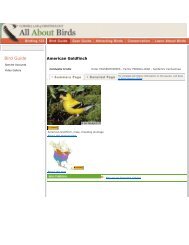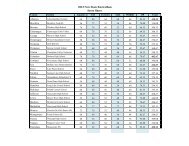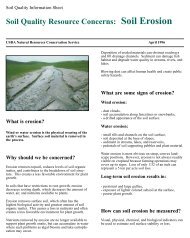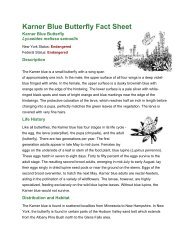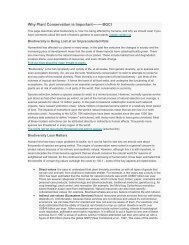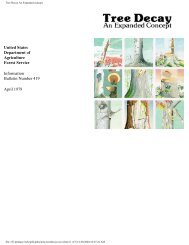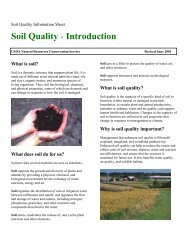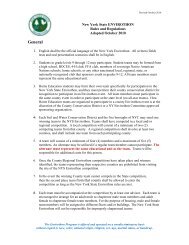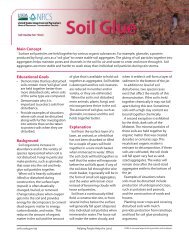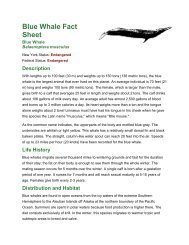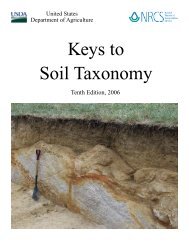Guidelines for Soil Quality Assessment in Conservation Planning
Guidelines for Soil Quality Assessment in Conservation Planning
Guidelines for Soil Quality Assessment in Conservation Planning
Create successful ePaper yourself
Turn your PDF publications into a flip-book with our unique Google optimized e-Paper software.
3. INVENTORY RESOURCES—ASSESSING SOIL QUALITY<br />
COLLECT BACKGROUND<br />
INFORMATION<br />
Visit the farm or ranch and collect<br />
<strong>in</strong><strong>for</strong>mation from the producer about<br />
current and previous uses of the site.<br />
Use the soil survey to provide<br />
<strong>in</strong><strong>for</strong>mation about the <strong>in</strong>herent properties<br />
of the soil(s). This <strong>in</strong><strong>for</strong>mation will help<br />
<strong>in</strong>tegrate the impacts of the <strong>in</strong>herent<br />
properties of the site with past, current,<br />
and future management. Use the <strong>Soil</strong><br />
<strong>Quality</strong> <strong>Assessment</strong> Field Record or case<br />
file to record <strong>in</strong><strong>for</strong>mation.<br />
Dur<strong>in</strong>g the Site <strong>Assessment</strong> (stage 1),<br />
collect <strong>in</strong><strong>for</strong>mation about the <strong>in</strong>herent<br />
properties of the site such as<br />
precipitation and soil map unit (soil<br />
type). While these characteristics cannot<br />
be modified, they will significantly<br />
affect the types of changes <strong>in</strong> soil quality<br />
that can be expected at a given site.<br />
Discuss Present/Future Management<br />
(stage 2) to determ<strong>in</strong>e whether the<br />
farmer is plann<strong>in</strong>g practices consistent<br />
with improv<strong>in</strong>g or ma<strong>in</strong>ta<strong>in</strong><strong>in</strong>g soil<br />
quality. For example, if a producer is<br />
about to convert a long-stand<strong>in</strong>g pasture<br />
to a cropp<strong>in</strong>g system, consider this<br />
change when predict<strong>in</strong>g the effects on<br />
soil quality. Understand<strong>in</strong>g management<br />
is critical to sett<strong>in</strong>g realistic goals <strong>for</strong><br />
soil quality levels.<br />
Past Management History (stage 3)<br />
helps establish the type of management<br />
that has been used and whether the<br />
current land use has been contribut<strong>in</strong>g to<br />
degradation of soil quality. For example,<br />
erod<strong>in</strong>g hillsides that have been planted<br />
to cont<strong>in</strong>uous corn could have very poor<br />
soil quality. Add<strong>in</strong>g a crop rotation with<br />
<strong>for</strong>ages or grasses or plant<strong>in</strong>g an annual<br />
w<strong>in</strong>ter cover crop could help improve<br />
soil quality.<br />
Gather <strong>in</strong><strong>for</strong>mation about various aspects<br />
of the operation, such as irrigation<br />
practices; types and rates of fertilizer,<br />
amendment, and manure applications;<br />
tillage systems, such as reduced or notill;<br />
and tillage operations, <strong>in</strong>clud<strong>in</strong>g<br />
ripp<strong>in</strong>g and subsoil<strong>in</strong>g. A general history<br />
cover<strong>in</strong>g the previous five to 10 years is<br />
optimal.<br />
Gather<strong>in</strong>g Producer Knowledge<br />
(stage 4) will allow producers to provide<br />
any other <strong>in</strong><strong>for</strong>mation or observations<br />
about the property that has not yet been<br />
discussed. Often, producers do not<br />
categorize <strong>in</strong><strong>for</strong>mation <strong>in</strong> the same way<br />
as specialists do. There<strong>for</strong>e, it is useful<br />
to cont<strong>in</strong>ue the discussion to allow<br />
producers to provide <strong>in</strong><strong>for</strong>mation which<br />
could be significant later <strong>in</strong> the<br />
assessment. For example, the farmer<br />
might po<strong>in</strong>t out annually occurr<strong>in</strong>g wet<br />
spots <strong>in</strong> the field, areas with low yields,<br />
or areas of salt accumulation. Such<br />
<strong>in</strong><strong>for</strong>mation helps determ<strong>in</strong>e effective<br />
methods <strong>for</strong> sampl<strong>in</strong>g.<br />
This discussion also provides an<br />
opportunity to discuss any problems that<br />
the farmer has observed at other times of<br />
the year such as erosion, heavy crust<strong>in</strong>g,<br />
or stunted growth. Open ended<br />
questions, such as, “What else can you<br />
tell me about the property that you th<strong>in</strong>k<br />
is significant <strong>for</strong> soil quality?” or “What<br />
11



